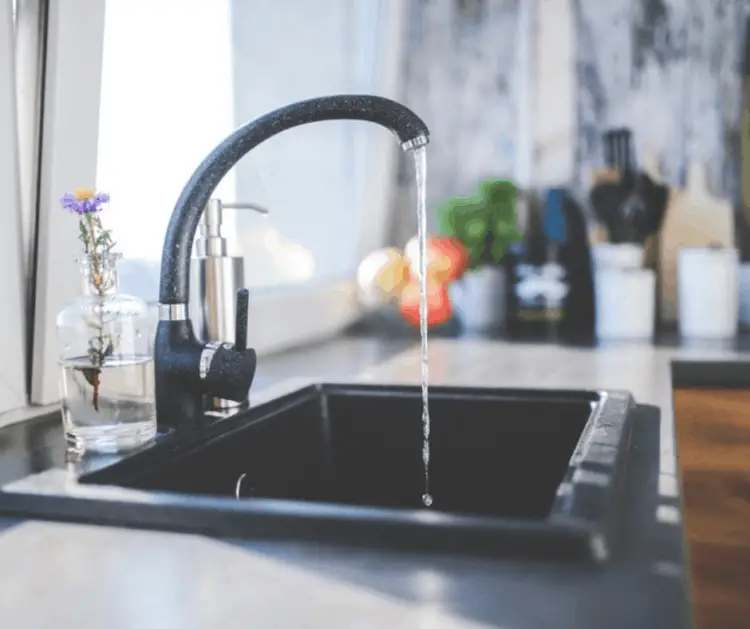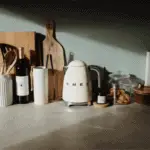Is Water From The Kitchen Sink Drinkable? Is Sink Water Safe to Drink? [2021 Guide]
When you are feeling thirsty while in your kitchen, would you take a drink from your kitchen sink? Do you feel uncomfortable drinking tap water when you are at home? You probably have suspicions whenever you are drinking water from your kitchen or bathroom sink.
Is the water safe to drink? Is water from the kitchen sink drinkable? Is sink water safe to drink? If all these questions cross your mind when you need a drink of water from your sink, then you are at the right place.
Answer: Even though the water in some cities has trace amounts of pollutants, most adults can safely drink from the sink tap in many areas. Tap water is still the most convenient way to keep your body replenished and fully hydrated.
Possible Contaminants in Tap Water
It is a widely known fact that all drinking water should be expected to contain small amounts of one kind of contaminant or the other. However, the presence of pollutants in the drinking water does not mean that it poses any health risks.
Some standards have been put in place that limit contaminants from industrial chemicals, parasites and bacteria, fertilizers, and other potentially harmful sources in your drinking water. The water distributed to your home is always taken through quality controls and tests to ensure that it is safe for drinking and does not contain excessive amounts of contaminants.
Another set of regulations prevents water from getting contaminants that might have harmful cosmetic effects such as skin or tooth discoloration. The enforcement of these rules is not a must, but some states have chosen to adopt them as enforceable standards and ensure the quality of water distributed to homes.
Is my Sink Water Safe?
Your sink has a tap where water comes in, and the faucet is connected to the distribution system of your water suppliers. Every year, the supplier is supposed to provide you with a water quality report that informs you about the water source and what is contained within it. Public water systems are also monitored to ensure that health standards are enforced and upheld regarding the contaminants in drinking water.
The supervision ensures that your water is safer and cleaner, which means that contaminants are reduced. You should also be informed immediately if your water source has been contaminated by something likely to cause illness.
People at Highest Risk if Water Gets Contaminated
Many healthy adults can drink tap and sink water without experiencing any issues or adverse side effects. However, certain groups are more susceptible to adverse health effects when drinking water has been contaminated. They include:
- very young children - pregnant women - the elderly - people with chronic illnesses - people who have weak immune systems
If you happen to be in any of the above-mentioned high-risk groups, you must consult your provider about any precautions or alternatives that you need to take.
Sink water can be risky for you if you have lower immunity as the small number of contaminants in the water will harm you. It is best to stay away from water from your kitchen sink and instead explore the other alternatives that we look at in the following sections.
Alternatives to Drinking Kitchen Tap Water
For anyone in a high-risk group or living in a city where the quality of the water has been compromised, there are some alternatives that you can use.
1. Bottled Water
This is an excellent temporary solution for when you feel that your tap water has been contaminated. However, it is essential that you only go for a brand whose quality has been verified.
Bottled water is usually regulated as food and will always require a means of identifying the water source. The levels of contaminants are also regulated, and there are always high manufacturing practice standards for the boiling and the bottling of the water.
Bottled water is also known to cost several times more than tap water, and as such, you must choose a brand that you can trust when you decide to invest. Additionally, it would help if you also were thinking about the long-term environmental impact that a bottled water habit will cause.
Apart from the vast amounts of fuel and energy used in the manufacture of bottles, around 75% of bottles usually end up in landfills, oceans, and lakes where they cannot decompose.
If your tap water supply is not in any danger, it is much better to buy a refillable bottle instead. This will ensure that you do not accumulate a vast amount of bottles in or around your environment and degrade the quality of life for yourself and the many other people living within your vicinity.
You will also be doing the environment a huge favor by buying these kinds of bottles when you have a refillable bottle. Additionally, your overall cost for the bottled water will be reduced, and you will be able to make savings on the refilling of the bottle.
2. Filters
Buy Brita Water Filter on Amazon
These are another viable alternative to tap water, and they provide better safety and cleanliness for the water you drink. Several different filters can be used to clean your water and ensure that your water is devoid of contaminants. Other impurities are known to have health risks and other complications. There are four main types of filters:
- Activated Carbon: This can remove specific organic contaminants from the water. It also absorbs tiny molecules and particles of impurities, leaving you with clean water that is safe to drink.
- Ion exchange units: These are systems that can get rid of minerals such as calcium and magnesium from the water. These chemicals make water hard, and when treated using the ion exchange units, the water becomes soft, clean, and safer for consumption. Soft water is also accessible on the stomach and is suitable for your health, so ion exchange units are used to purify water and ensure safe drinking.
- Reverse osmosis units: These are helpful water purification systems that can do much more than getting rid of impurities from drinking water. They can remove nitrated, sodium pesticides, and even petrochemicals. The units are efficient at getting rid of the more harmful contaminants in the water and leaving you with clean water that is safe to drink and healthier for you.
- Distillation Units: Boiling water has been the most common way of purifying water for a long time. By boiling the water and condensing the steam, we can get rid of heavy salts and other elements in the water. Distilled water is the most expensive form of bottled water, and the purification process gets rid of all the significant impurities from the water.
The boiling process is also essential for killing all kinds of organisms that are in the water, leaving you with water that is safer, cleaner, and even softer on your body organs since it no longer contains any heavy salts.
Whenever you are looking to invest in a filter, look for one that can remove the specific contaminant you are most concerned about. Also, look for filters that are certified by credible health and safety organizations in your area or state. Additionally, do not forget about the maintenance of your filter and ensure that you take care of it as per the manufacturer’s recommendations.
Additionally, you can make your sink water a lot safer for you to drink by installing a point-of-use filter on the kitchen sink. This filter will ensure that all the contaminants are caught before they can get to your sink, which means that you will be left with clean water safe for use.
3. Boiling
Boiling tap water can be adequate, but it also depends on what kind of contaminant you need to remove from the water. You can quickly kill germs at high temperatures, but this will not be effective enough for lead, nitrates, or pesticides.
Boiling has been known to increase the concentration of these contaminants since the water volume reduces when you boil it, but the level of the pollutants remains the same.
When you boil water, you will get rid of the germs, but heavy chemicals and other contaminants will remain in the water. It is essential to use different methods to filter the water after you boil it to ensure that you do not drink contaminated water. Letting the water cool down before bottling it is also recommended as the cooling process will cause the contaminants to settle at the bottom of the water.
Environmental Impact of Bottled Water
Bottled water is still very trendy and keeps stocking grocery shelves. However, the environmental impact of plastic bottles is significant. Most bottles usually end up being dumped in landfills as opposed to getting recycled. As such, tap water is still more appealing even though some factors determine its cleanliness and safety to drink.
When you are using bottled water, you will be forced to purchase many bottles. All these bottles have to be recycled to preserve the environment. If they are not recycled, then they will most likely be dumped in places where they will stay for a long time without decomposing.
When you are thinking of using bottled water as an alternative to the water in your sink, consider the environmental impact you will be causing. In some cases, it would be much better to keep using tap water with a filtration system installed than buy many bottles that will end up harming the environment.
Water Safety Levels by City
Some cities are taking steps and measures to ensure that their water source is kept clean and protected from all kinds of contamination. However, other cities are still very vulnerable to discharge coming from factories and other areas.
It is essential to check with your local authorities about the cleanliness of the water that is being distributed to your home and whether there is a factory that operates near your local reservoir. With this information, you will be able to determine whether the water in your sink is clean or otherwise contaminated.
The manufacturing industry has been known to be the leading source of water contamination in many cities. A lot of the waste they produce in their manufacturing processes is usually dumped into significant water bodies. The local authorities, such as the municipal council, do not do a single thing about it.
Doing a bit of research about your city, in particular, will give you more information about the current laws and regulations about where factories can and cannot dump their waste. You will also be in a position to know what measures your city takes to ensure that it only sources water from clean and uncontaminated sources. Your city should also be getting water from reliable sources that are not quickly depleted or dry up during the hot season since this is your lifeline.
If your city obtains its water from sources prone to contamination, then your sink water is not safe for you to drink. It is, therefore, vital that you take measures to ensure that you do not consume this water in the same form that it is piped to your home. Treating it before use or filtering it are some of the options that you can use to ensure that the water you are drinking is safer and has been eliminated from all the contaminants in the water.
Conclusion
Sometimes, you might have probably wondered whether the water in your kitchen sink is safe to drink. There might be many questions in your mind about the level of contaminants in the water and whether it is safe and healthy for you or not. However, any healthy adult can drink sink water without getting any health complications.
The high-risk groups are pregnant women and people that have low levels of immunity. For these people, alternatives are required, such as refillable water bottles, distillation, and filtration of the water, among other measures. Thankfully, the information that has been outlined above will be more than enough to guide your search for cleaner, safer and healthier drinking water.





